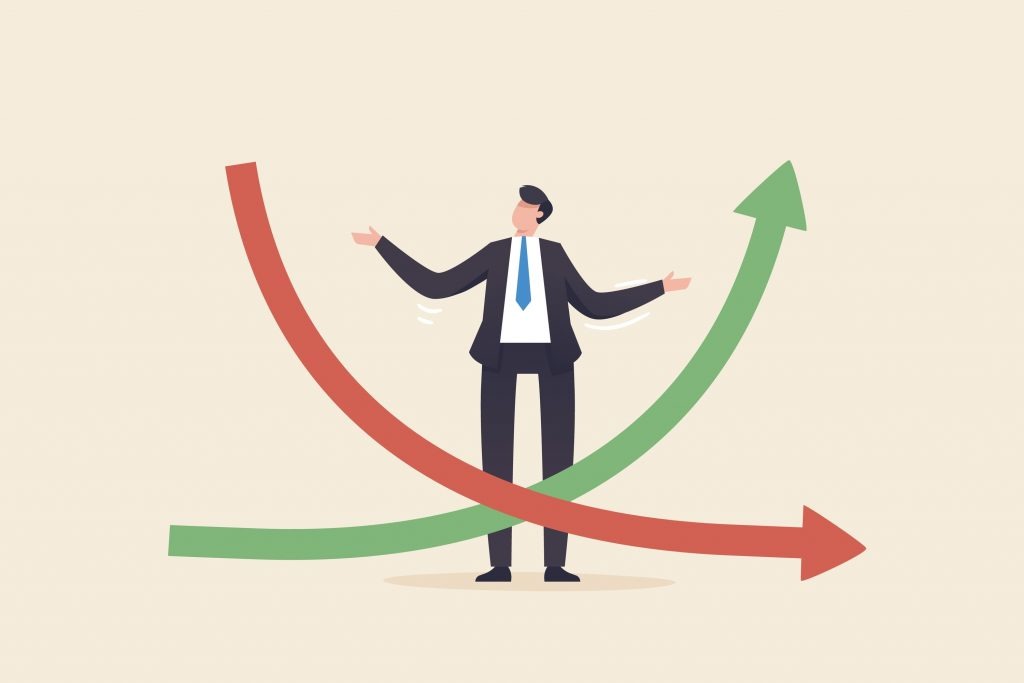Latest Yield Curve Signals that Expectations for the U.S. Economy are Deteriorating
On Nov. 22, the spread between the 2- and 10-year Treasury bonds extended to -73 basis points, marking the sharpest inversion in the U.S. yield curve since 1982

Historical data illustrates that corrections in the U.S. stock market are often accompanied by contractions in the underlying economy.
Case in point, 10 of the last 12 serious market corrections in the U.S. were accompanied by a contraction in the underlying economy. The only two exceptions occurred in 1962 and 1987.
Due to this strong link, investors and traders tend to monitor the U.S. economy closely for signs of a potential recession or depression. Due to its historical success in accurately predicting recessions, the yield curve is one of the most closely followed financial metrics on Wall Street.
In this context “yield” refers to the interest rates paid on U.S. government debt. The yield curve represents a timeline of interest rates across a range of different maturities on U.S. government debt (i.e. 2-year, 10-year, 30-year), and is typically presented in chart form.
A normal yield curve is usually described by a gradually rising line going from left to right on the chart—meaning interest rates rise as one goes further out in time. On the other hand, a so-called “inversion” of the yield curve occurs when short-term rates climb higher than longer-term rates—even if only for a brief period.
Source: CFI.com
One of the most closely followed relationships on the yield curve—especially when it comes to inversions—is the relationship between the yields of 2-year government bonds and 10-year government bonds.
An inversion occurs when the yield on 2-year government bonds is greater than the yield on 10-year government bonds. Examples of this phenomenon are shown in the graphic below, as the difference between the two yields (i.e. the spread) moves into negative territory.
Inversions involving the “2s and 10s” have precipitated the last several major recessions in the U.S. (periods of economic recession are shaded in grey).
Importantly, the 2s and 10s once again inverted during Q4 2022 (shown on the far-right in the above chart). On Nov. 22, the spread between the 2-year and 10-year extended to -73 basis points, marking the sharpest inversion since 1982.
In the last 40+ years, all major U.S. economic recessions have been foreshadowed by an inversion of the 2s and 10s. And while historical performance (or a historical pattern) is no guarantee of future performance, this is an important development.
At present, the yield on the 2-year U.S. Treasury is 4.48%, while the yield on the 10-year U.S. Treasury is 3.75% The severity of the inverse spread between the two—73 basis points—represents a multi-decade extreme in the relationship between these two well-known government bond yields.
Generally speaking, longer-term interest rates reflect future expectations for short-term interest rates. So when long-term rates drop below short-term rates, that generally means that future expectations for the underlying economy are deteriorating.
The U.S. Federal Reserve is currently in the middle of an aggressive campaign to raise interest rates in the U.S.—ostensibly to help fight inflation.
Unfortunately, rising interest rates make home loans, car loans, and pretty much every other type of loan more expensive. And higher financing costs tend to represent a headwind for the underlying economy.
At some point, the bite of higher financing costs will likely be too much for American consumers and businesses to bear—at which point, the Federal Reserve will be forced to stop raising benchmark rates. But at that point, the damage could already be irreversible, with the resulting “tightening of the belts” by consumers and businesses ultimately pushing the economy into recession.
Of course, there’s no guarantee that a recession or depression will materialize in the coming months, but for the time being, investors and traders would be well-served to monitor the ongoing changes to the U.S. yield curve.
In addition to the aforementioned data, it should be noted that the yield on the one-month Treasury bill is currently trading at a higher level than the yield on the 30-year Treasury bond—3.97% versus 3.82%, respectively. In the last 20 years, an inversion between these two bonds has only been observed on four occasions, and each and every instance was followed by a recession in the U.S. economy.
For more background on the current state of the yield curve, check out this new installment of Options Jive on the tastytrade financial network. This episode of Market Measures—focusing on the historical relationship between the yield curve and the stock market—is also recommended.
To follow everything moving the markets during the remainder of 2022, monitor TASTYTRADE LIVE, weekdays from 7 a.m. to 4 p.m. CDT.
Sage Anderson is a pseudonym. He’s an experienced trader of equity derivatives and has managed volatility-based portfolios as a former prop trading firm employee. He’s not an employee of Luckbox, tastytrade or any affiliated companies. Readers can direct questions about this blog or other trading-related subjects, to support@luckboxmagazine.com.



















